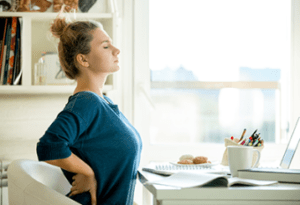Around 8.7 million people said that they worked from home in 2019 – less than 30% of the UK workforce – according to a survey by the Office for National Statistics. The same survey also reported that only 1.7 million regularly worked from home.
But since the outbreak of coronavirus this figure has risen dramatically, with all but the exception of key workers now working remotely. One media outlet reported that almost 90% of the work force was now based at home, and as of April 27, four million workers were on furlough status.
With this rapid change, the frontiers of occupational health and safety now undoubtedly stretch into spare rooms and kitchen tables across the UK.
Here are some considerations to take into account when managing the risk to home workers. You can find out more about these and other COVID-related accident prevention tips through RoSPA’s Accident Free Avoid A&E campaign.
Creating good work spaces
 As an employee setting up at home for the first time, you need to make sure you have performed a DSE assessment on your workspace, to avoid long-latency issues such as musculoskeletal disorders (like a bad back) and eyesight damage, and you need to check for trip hazards, such as trailing cables.
As an employee setting up at home for the first time, you need to make sure you have performed a DSE assessment on your workspace, to avoid long-latency issues such as musculoskeletal disorders (like a bad back) and eyesight damage, and you need to check for trip hazards, such as trailing cables.
Some health and safety managers would regard a laptop as only suitable as a temporary device for working from home. This is because using a laptop with an in-built keyboard and mouse can create strain on the wrists, and the inability to easily reposition the screen can cause pain. If you are using a laptop and it looks like you might be working at home for longer than a few months, you may wish to consider getting an external monitor, mouse and keyboard.
Routines
Having established a bespoke work space in home, it is also important to try to stick to routine. ITV recently reported that four in ten employees working from home are working longer hours than they would if they were operating form their normal place of work.
It can be tempting to stay in bed longer or check emails late into the evening, but it is vital for employees’ wellbeing that they are clear when they are ‘offline’ while working from home. Building movement into the working day can also help you get into a productive frame of mind.
Keeping in contact
One of the major drawbacks of working from home is a sense of isolation and a loss of close contact with colleagues. About one in four people in the UK will experience a mental health problem each year, and sudden changes in working environment necessitated to tackle COVID-19 may exacerbate existing mental health conditions. With this is in mind, it is important for line-mangers to be active in exercising their duty of care by regularly checking in with their team and revisiting their mental health risk assessments for homeworkers.
It may also be beneficial to set up more informal networks, such as a WhatsApp group or virtual coffee break meeting for colleagues, to keep in touch and promote a sense of community while many are working at distance.
Avoiding accidents in the home
Every year about 6,000 accidental deaths are caused by accidents in the home, more than any other environment, with a further 2.7million people turning up to A&E seeking treatment. With this in mind, the home could be considered the most dangerous place to be.
As part of the Accident Free Avoid A&E campaign, RoSPA has developed an information hub to help people working from home stay safe, and avoid putting additional pressure on the NHS.
Accident Free Avoid A&E provides advice on how to avoid common home accidents such as:
- DIY mishaps;
- Injuries to children;
- Slips, trips and falls.
A few weeks after the UK-wide lockdown measures were announced on March 23, Transport Secretary Grant Shapps remarked that: “It may well be that in future companies say, actually it has worked pretty well having some of our staff working from remote locations, why don’t we carry on doing that?”
Working from home could become the new normal for many in the UK, so we must make sure safety culture extends beyond the place of work.
Hear Karen talk as part of Safety & Health Expo’s Digital Week in a live webinar on Monday 18 May. Register here.
SHP, Barbour EHS and The Healthy Work Company have put together a hub to provide research, case studies, videos and resources to enable you to lead this transition in a way which safeguards the wellbeing of your teams and maximises the opportunity to embrace new ways of working for the future.
What makes us susceptible to burnout?
In this episode of the Safety & Health Podcast, ‘Burnout, stress and being human’, Heather Beach is joined by Stacy Thomson to discuss burnout, perfectionism and how to deal with burnout as an individual, as management and as an organisation.
We provide an insight on how to tackle burnout and why mental health is such a taboo subject, particularly in the workplace.

 As an employee setting up at home for the first time, you need to make sure you have performed a
As an employee setting up at home for the first time, you need to make sure you have performed a 